FUNCTIONAL ENDOSCOPIC
SINUS SURGERY- ENDOSCOPIC SKULL BASE SURGERY
High level of surgical expertise based on:
-
15 years of training under the guidance of internationally reputable ENT surgeons (Prof. W. Draf, Prof. H. Iro, Prof. M.E Wigand)
- Continuous education and treatment (Participation in 10-15 conferences and surgical training courses as an invited speaker and training surgeon respectively on a year basis)
- Use of navigation system technology in order to achieve a higher level of intraoperative accuracy and safety.
- Colaboration with excellent neurosurgeons, when needed, in cases of skull base tumors.
You can watch some case studies from each category of surgeries in Youtube in the following link:
Reference Center
Διεθνές κέντρο αναφοράς χειρουργικής παραρρινίων κόλπων και βάσεως του κρανίου με το σύστημα νευροπλοήγησης SCOPIS
https://navigation.scopis.com/#References


Chronic rhinosinusitis
When the conservative treatment fails to improve the symptoms of chronic rhinosinusitis, Functional Endoscopic Sinus Surgery (FESS) can be performed. Its main advantage is the fact that the operation is performed through the nostrils, without the need of external incisions εensuring an excellent aesthetic…

Nasal polyposis- Chronic rhinosinusitis with nasal polyps
In this section of the site you can find CT scans (computed tomography scans) of patients with nasal polyps, as well as videos about the removal of the polyps and the drainage of the paranasal sinuses with the use of a shaver, post-operative videos and endoscopic post- operative photos of the patients.

Mucoceles- Mucopyoceles
Mucoceles are formed when the drainage of a sinus is disrupted, resulting in the formation of a sac filled with mucous inside the sinus. The inflammation of the mucus leads to the formation of a mucopyocele. If the blockage of the drainage pathway is not lifted, the mucocele grows bigger and can potentially…

Treatment of cerebrospinal fluid fistulae (CSF fistulae/ leak)
Erosion or trauma of the skull base results in cerebrospinal fluid fistulae that can be complicated with meningitis or encephalitis. Common causes of CSF leaks are chronic inflammation of the skull base, trauma (car accidents) or iatrogenic trauma during procedures on the paranasal sinuses and the skull base. Rarely, CSF leaks result from increased intracranial pressure (idiopathic intracranial hypertension) or congenital skull base bony dehiscences.
The endoscopic treatment of CSF fistulae is a revolutionary technique as the procedure takes place endonasally without external incisions, providing the patient with a minimally invasive alternative to a craniotomy. The endoscopic treatment is characterized by a lower morbitity rate, less complications, as well as shorted duration of patient hospitalization.
We must also underline the importance of smell restoration for these patients, since smell is often impaired when a craniotomy is performed. Nevertheless, the aesthetic result in all
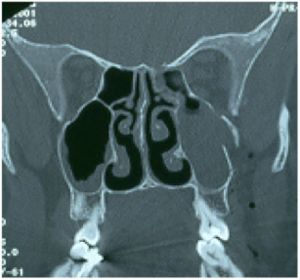
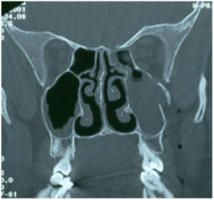
Μετατραυματικό συρίγγιο εγκεφαλονωταιίου υγρού (ΕΝΥ) οροφής ηθμοειδούς οστού αριστερά. Αξονική τομογραφία.
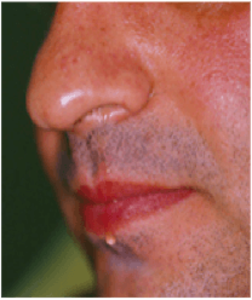
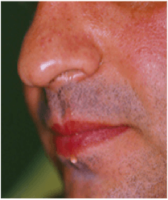
Ρινόρροια του ασθενούς
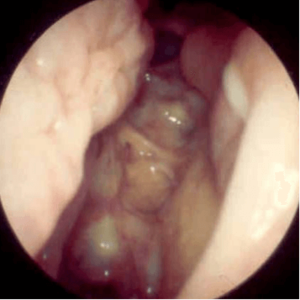
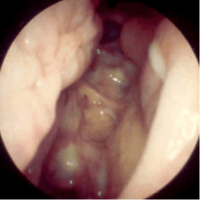
Ενδοσκοπική εικόνα 2 χρόνια μετεγχειρητικά
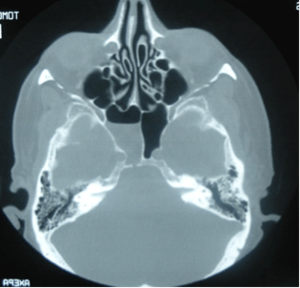
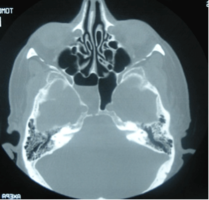
Αυτόματο συρίγγιο ΕΝΥ. Αξονική τομογραφία με οστικό έλλειμμα του σφηνοειδούς κόλπου δεξιά.


Μαγνητική τομογραφία 18 μήνες μετά την επέμβαση.

Ενδοσκοπική σύγκλειση μετατραυματικού συριγγίου ΕΝΥ στην οροφή του ηθμοειδούς αριστερά.

Αυτοματο συριγγιο σφηνοειδους κολπου
Ενδοσκοπική διάνοιξη του σφηνοειδούς κόλπου δεξιά με αναγνώριση και σύγκλειση του συριγγίου.

Meningoceles- Meningoencephaloceles
Meningoceles and meningoencephaloceles are formed by the protrusion of the meninges and the brain through a congenital or acquired dehiscence of the skull base inside the nose. They can be complicated with meningitis and encephalitis. Meningoceles/ meningoencephaloceles fall under three categories:…

Osteomas- Fibromas- Fibrous Dysplasia
Osteomas are benign tumors characterized by gradual growth, presenting with headaches, disrupting the mucus drainage from the paranasal sinuses leading to inflammation.
Rarely osteomas can invade the orbit, resulting in exophthalmos, diplopia and optokinetic dysfunction or the skull base…

Inverted papilloma
Inverted papilloma is a benign tumor that can rarely undergo malignant transformation. Its removal must be complete and thorough in order to prevent recurrences. The endoscopic removal is the method of choice characterized by lower morbidity rates and less complications compared to external approaches.

Juvenile nasopharyngeal angiofibroma
Juvenile angiofibroma is a benign but locally aggressive tumor with excessive vascularization. It commonly affects young children and adolescent males, causing headache, nasal obstruction and epistaxis. In very advanced cases, the tumor can erode the skull base and extend intracranially.
Prior…

Carcinoma (adenocarcinoma, squamous cell carcinoma)
Carcinoma is the most common malignant tumor of nose and the paranasal sinuses. Adequate surgical resection is the treatment of choice in most cases and should take place as close to the diagnosis as possible, whereas locally advanced tumors require a combination of surgical resection and radiation.…

Olfactory neuroblastoma (esthesioneuroblastoma)
Olfactory neuroblastoma is a malignant tumor that is believed to originate from the olfactory epithelium, the olfactory filaments and the olfactory bulb. The treatment requires endoscopic surgical resection often combined with intracranial resection in cases of locally advanced tumors. The endoscopic…

Sarcomas (Rhabdomyosarcoma, chondrosarcoma)
Sarcomas are malignant tumors of the nose and the paranasal sinuses. They are the most common malignant tumors in childhood. The treatment of choice is complete resection with restoration of the valuable anatomic structures of the nose and the sinuses. Endoscopic resection is an alternative to the…

Restoration of skull base defects and defects of the anterior frontal sinus wall.
Defects of the skull base as well as the anterior wall of the frontal sinus are associated with disruption of the normal function as well as aesthetic deformation and are treated surgically. Common causes are chronic inflammation, tumors and prior surgery on these areas.